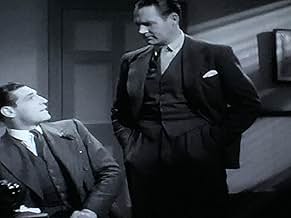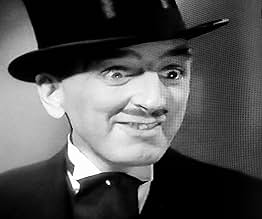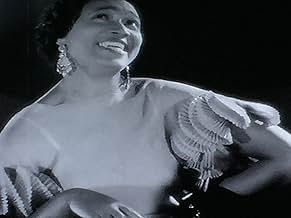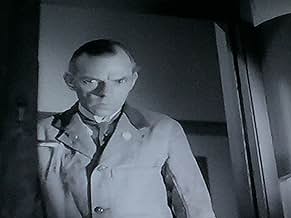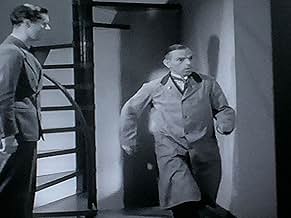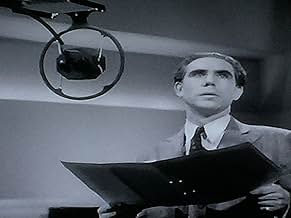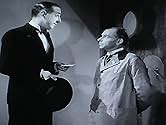Agrega una trama en tu idiomaWhen an actor is murdered at the BBC Inspector Gregory finds he has many suspects to choose from.When an actor is murdered at the BBC Inspector Gregory finds he has many suspects to choose from.When an actor is murdered at the BBC Inspector Gregory finds he has many suspects to choose from.
- Dirección
- Guionistas
- Elenco
Lilian Oldland
- Joan Dryden
- (as Mary Newland)
Betty Ann Davies
- Poppy Levine
- (as Betty Davies)
Gershom Parkington
- Gershom Parkington - Musician
- (as Gershom Parkington Quintette)
- Dirección
- Guionistas
- Todo el elenco y el equipo
- Producción, taquilla y más en IMDbPro
Opiniones destacadas
The querulous, and frequently catty cast of a lurid radio play distressingly find them crime, as one of them is murdered by malevolent persons unknown! Sleekly suave Det. Inspector Gregory (Ian Hunter) is called upon to investigate the dastardly strangler in this splendidly entertaining 1930s whodunnit, greatly enlivened by a remarkably droll text, and many colourfully theatrical performances from an amusingly stiff upper-lipped cast of erudite British Thespians, including a very young Jack Hawkins. 'Death at Broadcasting House is ripping good yarn, energetically told by a fine ensemble cast of actors. 'Murder Immaculate indeed!' This consistently engaging thriller works splendidly as escapist entertainment, and is doubly fascinating as a delightfully vivid document of the frightfully middle-class milieu of Broadcasting House in the 1930s, it's truly wonderful that such beautifully made films are still available for future generations of film fans to enjoy.
This is really two stories in one. The first is the underlying plot of a murder during a live radio broadcast of a play so that the actual death by strangling of Donald Wolfit (before he became famous), is the real thing. Having been previously castigated by producer Val Gielgud (who actually wrote the film storyline as well) for not gasping properly, he is summoned to be congratulated on his improved performance only to be found stretched out on the floor, dead. There are several plausible suspects who all had the opportunity and motive to commit the crime but the actual culprit seemingly has a cast iron alibi. His unmasking therefore comes as a genuine surprise with the final chase through Broadcasting House bringing about his demise when he enters a door without realising it is a live electricity station. The second story is that of the daily routine in Broadcasting House where we are treated to two top stars of the day, Elisabeth Welch and Eve Becke, delightfully singing to the accompaniment of Ord Hamilton at the piano and Percival Mackey's dance orchestra respectively. Interweaved and connecting both stories is a gormless intruder who goes all over the building in search of the Variety studio, upsetting everyone in the process and also becoming a prime murder suspect. Other people come and go, mischievously signing autographs outside the front door. A gripping film, the only disappointment being that the police inspector never reveals his evidence until right at the end, thus depriving the viewer of accurately guessing whodunit.
Although terribly dated and about a form of media that is passe in modern times, Death of a Broadcast is still an entertaining whodunnit. The death of one of the radio actors during a live broadcast is the basis for the film.
The actor is strangled during a scene in which he is supposed to be strangled in the play. The coincidence of events is very convenient for the killer. A rather novel murder mystery then unfolds. Worth viewing despite the dated content.
The actor is strangled during a scene in which he is supposed to be strangled in the play. The coincidence of events is very convenient for the killer. A rather novel murder mystery then unfolds. Worth viewing despite the dated content.
I always give early-1930s movies the benefit of the doubt, and I'm doing so here. An actor working alone in a radio studio room is murdered while reading his lines (in which his character is murdered). Someone in the studio building at the time killed him, but whom? There are only a few possible culprits, and most aren't very well defined characters. A few years later, this probably could have been a very good movie, but it's barely passable here. I suspect much of the appeal of this film when it was released came from the behind-the-scenes look at a working radio studio, with actors in multiple rooms, and orchestra in another, and crew in still others. You even get a song and a dance number, although the appeal of a dance number on radio, including dancers in full costume, escapes me.
If you enjoy 1930s crime/mysteries, then this is worth a watch. The detective doesn't define himself particularly well, but the genre plays out reasonably true to form. I gave it a 6 for slightly better than average.
If you enjoy 1930s crime/mysteries, then this is worth a watch. The detective doesn't define himself particularly well, but the genre plays out reasonably true to form. I gave it a 6 for slightly better than average.
While dozens of people go about their jobs of getting news and entertainment out on the BBC -- including a chorus of dancers in elaborate costumes -- a minor actor is being rehearsed for a role in an original crime drama. His screams as he is strangled -- in the role -- are not satisfactory. However, during the performance, he gives a much better performance. That's because he is strangled and his corpse left by the microphone.
It's a production with a fancy background, and a cast that includes several well-known broadcasters and performers of the era. Ian Hunter is the Scotland Yard inspector who investigates -- in contrast to American movies, in which it's a private citizen or detective, or a government investigator with a chip on his shoulder who solves the case, in Britain in this era, it was someone more official and with less personality quirks. Among the suspects are Austin Trevor, Val Gielgud (who wrote the book this movie is based on) and Jack Hawkins.
It's directed for efficiency by Reginald Denham, and the cinematographer is Gunther Krampf. Although he is best remembered for his impressionist work for Pabst, he lights the Art Moderne sets here brightly and flatly. Still, although the mystery is well done and the method used to identify the murderer sound good, I thought there was little of humanity or interesting characters in the movie.
It's a production with a fancy background, and a cast that includes several well-known broadcasters and performers of the era. Ian Hunter is the Scotland Yard inspector who investigates -- in contrast to American movies, in which it's a private citizen or detective, or a government investigator with a chip on his shoulder who solves the case, in Britain in this era, it was someone more official and with less personality quirks. Among the suspects are Austin Trevor, Val Gielgud (who wrote the book this movie is based on) and Jack Hawkins.
It's directed for efficiency by Reginald Denham, and the cinematographer is Gunther Krampf. Although he is best remembered for his impressionist work for Pabst, he lights the Art Moderne sets here brightly and flatly. Still, although the mystery is well done and the method used to identify the murderer sound good, I thought there was little of humanity or interesting characters in the movie.
¿Sabías que…?
- TriviaThis film received its earliest documented USA telecasts in Los Angeles Sunday 16 October 1949 on KFI (Channel 9) and in New York City Saturday 11 February 1950 on WPIX (Channel 11).
- Citas
Rodney Fleming: [to the lift-man] I'm looking for Variety.
lift-man: That's eight floors down.
Rodney Fleming: But I've just come eight floors up!
lift-man: Then it'll be sixteen floors down.
- ConexionesReferenced in Those British Faces: A Tribute to Jack Hawkins 1910-1973 (1993)
Selecciones populares
Inicia sesión para calificar y agrega a la lista de videos para obtener recomendaciones personalizadas
Detalles
- Fecha de lanzamiento
- País de origen
- Idioma
- También se conoce como
- Death at a Broadcast
- Locaciones de filmación
- A.S.P.I. Studios, Wembley Park, Middlesex, Inglaterra, Reino Unido(studio: produced at A · S · P · I Studios Wembley Park)
- Productora
- Ver más créditos de la compañía en IMDbPro
- Tiempo de ejecución1 hora 15 minutos
- Color
- Relación de aspecto
- 1.37 : 1
Contribuir a esta página
Sugiere una edición o agrega el contenido que falta

